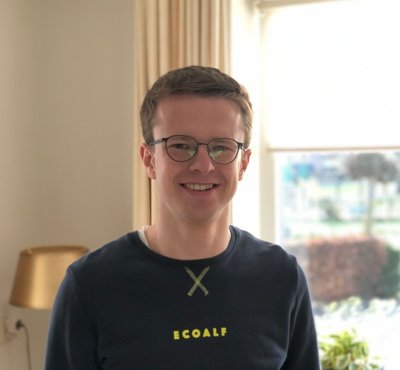Spin-dependent phenomena in superconductor hybrid structures
Tim Kokkeler is a PhD student in the Department of Interfaces and Correlated Electron Systems. Promotors are prof.dr.ir. J.W.M. Hilgenkamp from the Faculty of Science & Technology and prof.dr. S.F. Bergeret from the Centro de Fisica de Materiales and Donostia International Physics Center.
 This thesis describes the interplay of the superconducting proximity effect of conventional and unconventional superconductors with materials that are magnetic or have spin-orbit coupling. The different Chapters in this thesis predict that this interplay yields several interesting emergent phenomena, such anomalous currents and superconducting diode effects. Several theoretical tools were developed, in order to describe the superconducting proximity effect junctions with spin-orbit orbit coupling or unconventional magnetism, and to identify the pairing symmetry of unconventional superconductors. With this, the thesis provides several proposals that can be experimentally verified and can be used to understand materials in more detail.
This thesis describes the interplay of the superconducting proximity effect of conventional and unconventional superconductors with materials that are magnetic or have spin-orbit coupling. The different Chapters in this thesis predict that this interplay yields several interesting emergent phenomena, such anomalous currents and superconducting diode effects. Several theoretical tools were developed, in order to describe the superconducting proximity effect junctions with spin-orbit orbit coupling or unconventional magnetism, and to identify the pairing symmetry of unconventional superconductors. With this, the thesis provides several proposals that can be experimentally verified and can be used to understand materials in more detail.
The three main achievements obtained within this thesis are the following. A formalism is developed to derive the transport equations and corresponding boundary conditions for a large range of materials through the construction of the quasiclassical action, called the nonlinear sigma model (NLSM), based on phenomenological symmetry considerations. Using this approach the theory of transport in the presence of a broad range of magnetic and spin-orbit interactions is developed. This theory is used for the prediction of several effects that can be used to characterize materials in which these phenomena are present. From a theoretical point of view there are a few main research directions that can emerge based on this development. First of all, the equations developed in this thesis can be used in different geometries, or in time-dependent problems. Next to this, the theories can be combined to describe magnetic materials with spin-orbit coupling, to study the interplay of the simultaneous presence of spin-orbit coupling and magnetism. Next to this, the approach can be applied to other types of systems, such as those with a valley degree of freedom. A main future objective along this line would be to extend the developed arguments to multiband systems. Moreover, while in this thesis the action is mainly used to derive the transport equations, the NLSM is more powerful then the Usadel equation alone. Response functions and observables can be calculated directly from the action, while a renormalization group analysis of the parameters in the action may reveal several interesting properties, such as the behavior of materials with spin-orbit coupling and magnetism near the metal insulator transition.
The second main achievement is the characterization of gyrotropy on multiple scales, which explains that non-reciprocal transport may appear in junctions in which none of the materials contains microscopic gyrotropy. To this end we have shown that superconducting diode effects exist even in cubic normal metals with a nonzero spin-Hall angle, when in contact with a ferromagnetic insulator on one side and a superconductor on another side. The mirror symmetry breaking along the interface is enough to make the junction gyrotropic. This result shows that there is a large number of materials suitable for constructing this cornerstone in superconducting spintronics. Our results and our symmetry considerations show that the predicted diode effect requires the exchange field to be large compared to the relaxation. This means that ferrimagnets are not suitable for superconducting diodes, and it indicates that good interfaces are important and the spins need to be aligned well. The developed tools were used to predict several experimentally measurable effects. These predictions can be tested using junctions with conventional superconductors, such as Nb and ferromagnetic insulators, such as EuS or EuO, and materials with large spin-Hall angle, such as Pd or Pt. From a theoretical point of view it would be interesting to consider the influence of a different structure of the spin-Hall tensor, as is allowed in several materials. Moreover, it is also possible that near the boundary the material becomes gyrotropic on a microscopic level. The interplay between the two types of spin-charge coupling is largely unexplored and may lead to novel results.
The third main achievement is the development of the theory of noise in junctions with unconventional superconductors. This theory is subsequently used to show that noise is a suitable tool for the clarification of the pairing symmetry of unconventional superconductors, because surface Andreev bound states yield distinctive signatures in the differential Fano factor, the ratio of the differential noise power and the conductance. Moreover, the results show that increasing temperature, makes these features stronger. The results presented in this thesis can be used by experimentalists to investigate several types of superconductors. The theory is constructed not only for tunnel junctions, but also for junctions that are described by a transmission eigenvalue distribution, such as diffusive, double barrier and chaotic cavity junctions and therefore provides a multitude of experimentally verifiable predictions. From a theoretical perspective, it would be interesting to extend this theory to multiband superconductors that host Bogoliubov Fermi surfaces of bound states, and next to this to study the noise of spin currents and thermal currents, which can proceed following a similar approach as introduced in this thesis.





